Deck 16: China and Korea to 1279
Question
Question
Question
Question
Question
Question
Question
Question
Question
Question
Question
Question
Question
Question
Question
Question
Question
Question
Question
Question
Question
Question
Question
Question
Question
Question
Question
Question
Question
Question
Question
Question
Question
Question
Question
Question
Question
Question
Question
Question
Question
Question
Question
Question
Question
Question
Question
Question
Question
Question

Unlock Deck
Sign up to unlock the cards in this deck!
Unlock Deck
Unlock Deck
1/50
Play
Full screen (f)
Deck 16: China and Korea to 1279
1
Which of the following would describe the Silla rulers' perception of the Buddhist temples they built in and around their capital city, Kyongju?
A) As extensions of royal power
B) As seats of civil power
C) As places for worship
D) As supernatural defenses
A) As extensions of royal power
B) As seats of civil power
C) As places for worship
D) As supernatural defenses
D
2
Which of the following would explain the artist's decision to depict an exemplar moral and political virtue in Yan Liben's The Thirteen Emperors ?
A) The Daoist ideal of retreat from society to attain wisdom in nature
B) The system of laws and belief set forth by the Chinese first emperor
C) The ideal of good government as seen in Gandharan India
D) The Confucian ideal of learning from the past to create an ordered society
A) The Daoist ideal of retreat from society to attain wisdom in nature
B) The system of laws and belief set forth by the Chinese first emperor
C) The ideal of good government as seen in Gandharan India
D) The Confucian ideal of learning from the past to create an ordered society
D
3
Which of the following statements best describes Shang bronze vessel work?
A) Only certain vessel forms received animal and abstract surface decoration.
B) Designs and decoration are fully integrated to suit each vessel form.
C) Each single design would be applied to only one vessel form.
D) Vessel form had little relation to the intended function of the object.
A) Only certain vessel forms received animal and abstract surface decoration.
B) Designs and decoration are fully integrated to suit each vessel form.
C) Each single design would be applied to only one vessel form.
D) Vessel form had little relation to the intended function of the object.
B
4
What is the explanation for one figure being represented as larger than the others in one of the scenes from the Wu family shrine?
A) The larger size of the figure means he is a deity.
B) The larger size of the figure is an attempt at perspective.
C) The larger size of the figure means he is a deceased ancestor.
D) The larger size of the figure highlights his importance.
A) The larger size of the figure means he is a deity.
B) The larger size of the figure is an attempt at perspective.
C) The larger size of the figure means he is a deceased ancestor.
D) The larger size of the figure highlights his importance.

Unlock Deck
Unlock for access to all 50 flashcards in this deck.
Unlock Deck
k this deck
5
A broad range of subject matter, such as musicians on camel or Semitic traders, can be found in the ceramic figural tradition of which of the following?
A) Shang dynasty
B) Tang dynasty
C) Zhou dynasty
D) Six Dynasties
A) Shang dynasty
B) Tang dynasty
C) Zhou dynasty
D) Six Dynasties

Unlock Deck
Unlock for access to all 50 flashcards in this deck.
Unlock Deck
k this deck
6
Which Bronze Age dynasty did the 1928 excavations at Anyang reveal as a warlike and stratified society?
A) Xia dynasty
B) Zhou dynasty
C) Shang dynasty
D) Han dynasty
A) Xia dynasty
B) Zhou dynasty
C) Shang dynasty
D) Han dynasty

Unlock Deck
Unlock for access to all 50 flashcards in this deck.
Unlock Deck
k this deck
7
Which country provided the cultural link between China and Japan?
A) Mongolia
B) Siberia
C) Korea
D) India
A) Mongolia
B) Siberia
C) Korea
D) India

Unlock Deck
Unlock for access to all 50 flashcards in this deck.
Unlock Deck
k this deck
8
The Neolithic Majiayao Culture is notable for which art form?
A) Bronzes
B) Jades
C) Calligraphy
D) Pottery
A) Bronzes
B) Jades
C) Calligraphy
D) Pottery

Unlock Deck
Unlock for access to all 50 flashcards in this deck.
Unlock Deck
k this deck
9
What is the name of the philosophy-a blend of traditional Chinese thought and selected Buddhist concepts-that flourished during the Southern Song period?
A) Neo-Chanism
B) Neo-Buddhism
C) Neo-Daoism
D) Neo-Confucianism
A) Neo-Chanism
B) Neo-Buddhism
C) Neo-Daoism
D) Neo-Confucianism

Unlock Deck
Unlock for access to all 50 flashcards in this deck.
Unlock Deck
k this deck
10
The Chinese interest in landscape painting was most strongly influenced by which of the following?
A) Confucius's dictum that an appreciation of nature was the basis for human society
B) Buddhist concern with dharma and cosmic principles
C) The Buddhist concept of nirvana and how that paradise is depicted in art
D) Daoist emphasis on harmony with nature and poetic themes
A) Confucius's dictum that an appreciation of nature was the basis for human society
B) Buddhist concern with dharma and cosmic principles
C) The Buddhist concept of nirvana and how that paradise is depicted in art
D) Daoist emphasis on harmony with nature and poetic themes

Unlock Deck
Unlock for access to all 50 flashcards in this deck.
Unlock Deck
k this deck
11
How does Fan Kuan reflect Daoist sensitivity in Travelers among Mountains and Streams ?
A) By minimizing the human element
B) By focusing on the mountains and minimizing the human element
C) By minimizing the mountains
D) By using sparse lines and no shading
A) By minimizing the human element
B) By focusing on the mountains and minimizing the human element
C) By minimizing the mountains
D) By using sparse lines and no shading

Unlock Deck
Unlock for access to all 50 flashcards in this deck.
Unlock Deck
k this deck
12
The Qin ruler Shi Huangdi, the first emperor of China, is remembered in art history for which of the following?
A) The numerous bronze vessels buried with him
B) The beautiful pieced-jade suit in which he was buried
C) The army of life-size warriors and horses he commissioned for his tomb
D) His recognition of Buddhism as the official religion of China
A) The numerous bronze vessels buried with him
B) The beautiful pieced-jade suit in which he was buried
C) The army of life-size warriors and horses he commissioned for his tomb
D) His recognition of Buddhism as the official religion of China

Unlock Deck
Unlock for access to all 50 flashcards in this deck.
Unlock Deck
k this deck
13
What material comprises the Shakyamuni Buddha of the Six Dynasties, the first precisely datable Chinese Buddhist image?
A) Red lacquered wood
B) Gilded wood
C) Gilded bronze
D) Painted stone
A) Red lacquered wood
B) Gilded wood
C) Gilded bronze
D) Painted stone

Unlock Deck
Unlock for access to all 50 flashcards in this deck.
Unlock Deck
k this deck
14
The Korean Hwangnam-dong crown, with its gold band and uprights, and jade comma-shaped pieces, is thought to symbolize which of the following?
A) Silla Kingdom first ancestor
B) Life and supernatural power
C) Life and the eternal sun
D) The tears of the Buddha
A) Silla Kingdom first ancestor
B) Life and supernatural power
C) Life and the eternal sun
D) The tears of the Buddha

Unlock Deck
Unlock for access to all 50 flashcards in this deck.
Unlock Deck
k this deck
15
Which of the following would have been included in the reorganized curriculum for court artists set up by Emperor Huizong?
A) Study of the tactical methods of the Mongols
B) Study of the classical Chinese art of earlier periods
C) Study of the calligraphic art of Nara, Japan
D) Study of the governing methods of the first emperor
A) Study of the tactical methods of the Mongols
B) Study of the classical Chinese art of earlier periods
C) Study of the calligraphic art of Nara, Japan
D) Study of the governing methods of the first emperor

Unlock Deck
Unlock for access to all 50 flashcards in this deck.
Unlock Deck
k this deck
16
Which of the following is characteristic of the Han pictorial style?
A) Use of linear perspective devices
B) Gold-leaf backgrounds
C) Absence of floral motifs
D) Round forms with rhythmic contours
A) Use of linear perspective devices
B) Gold-leaf backgrounds
C) Absence of floral motifs
D) Round forms with rhythmic contours

Unlock Deck
Unlock for access to all 50 flashcards in this deck.
Unlock Deck
k this deck
17
One of the most important goals of the Chinese artist was which of the following?
A) To highlight man's complete domination of the natural world
B) To impose a mathematical structure on the chaos of nature
C) To demonstrate his own individual and distinctive style
D) To serve as an instrument through which nature could reveal itself
A) To highlight man's complete domination of the natural world
B) To impose a mathematical structure on the chaos of nature
C) To demonstrate his own individual and distinctive style
D) To serve as an instrument through which nature could reveal itself

Unlock Deck
Unlock for access to all 50 flashcards in this deck.
Unlock Deck
k this deck
18
In the Vairocana Buddha, the Tang sculptors have repressed and replaced surface detail with which of the following?
A) Austere formalism
B) Sensuous fleshiness
C) Monumental simplicity
D) Clinging drapery
A) Austere formalism
B) Sensuous fleshiness
C) Monumental simplicity
D) Clinging drapery

Unlock Deck
Unlock for access to all 50 flashcards in this deck.
Unlock Deck
k this deck
19
Impressive celadon ceramics were produced during which of the following periods?
A) The Great Silla dynasty
B) The Yi dynasty
C) The Goryeo dynasty
A) The Great Silla dynasty
B) The Yi dynasty
C) The Goryeo dynasty

Unlock Deck
Unlock for access to all 50 flashcards in this deck.
Unlock Deck
k this deck
20
Which of the following best describes the Tang court and the art it commissioned?
A) Mystical and magical
B) Xenophobic and reclusive
C) Isolated and withdrawn
D) Worldly and self-assured
A) Mystical and magical
B) Xenophobic and reclusive
C) Isolated and withdrawn
D) Worldly and self-assured

Unlock Deck
Unlock for access to all 50 flashcards in this deck.
Unlock Deck
k this deck
21
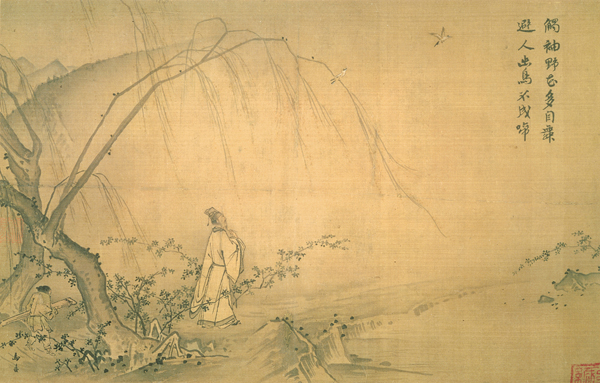
Under which dynasty did Ma Yuan paint this work?
A) Han
B) Northern Song
C) Tang
D) Southern Song

Under which dynasty did Ma Yuan paint this work?
A) Han
B) Northern Song
C) Tang
D) Southern Song

Unlock Deck
Unlock for access to all 50 flashcards in this deck.
Unlock Deck
k this deck
22
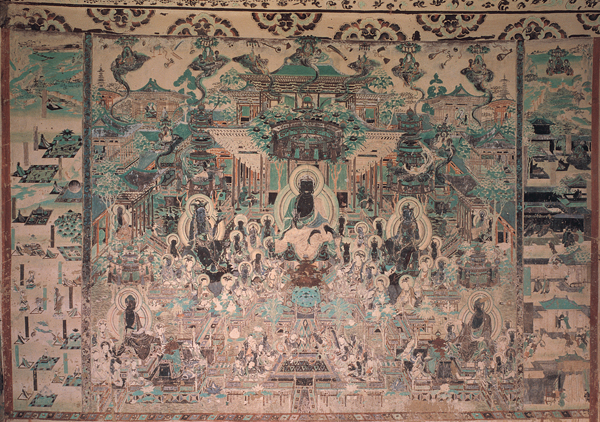
What is the name of the central figure in this artwork?
A) Shakyamuni
B) Amitabha
C) Guanyin
D) Harihara

What is the name of the central figure in this artwork?
A) Shakyamuni
B) Amitabha
C) Guanyin
D) Harihara

Unlock Deck
Unlock for access to all 50 flashcards in this deck.
Unlock Deck
k this deck
23
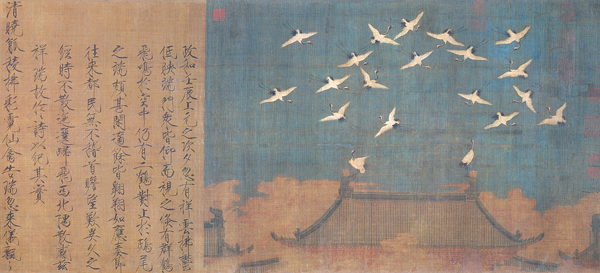
The text and images on this handscroll are attributed to which artist?
A) Gu Kaizhi
B) Ma Yuan
C) Fan Kuan
D) Huizong

The text and images on this handscroll are attributed to which artist?
A) Gu Kaizhi
B) Ma Yuan
C) Fan Kuan
D) Huizong

Unlock Deck
Unlock for access to all 50 flashcards in this deck.
Unlock Deck
k this deck
24
Which style of 12th-century Korean pottery was recognized worldwide and highly sought after?
A) Cizhou ware
B) Celadon ware
C) Stoneware
D) Majiayao ware
A) Cizhou ware
B) Celadon ware
C) Stoneware
D) Majiayao ware

Unlock Deck
Unlock for access to all 50 flashcards in this deck.
Unlock Deck
k this deck
25
Which of the following is most characteristic of the paintings of the northern Song artist Fan Kuan?
A) Massive human figures
B) Shifting perspective
C) Bright contrasting colors
D) Minimalist landscapes
A) Massive human figures
B) Shifting perspective
C) Bright contrasting colors
D) Minimalist landscapes

Unlock Deck
Unlock for access to all 50 flashcards in this deck.
Unlock Deck
k this deck
26
Which of the following brought Buddhism to China?
A) The Buddha himself
B) The Silk Road
C) The Gandharan invasion
D) Lady Feng after her travels
A) The Buddha himself
B) The Silk Road
C) The Gandharan invasion
D) Lady Feng after her travels

Unlock Deck
Unlock for access to all 50 flashcards in this deck.
Unlock Deck
k this deck
27
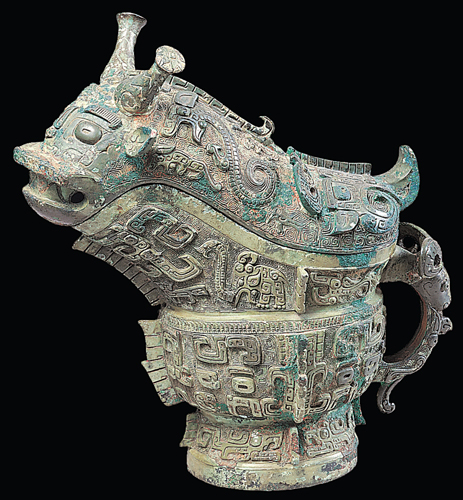
Under which dynasty was this object made?
A) Qin
B) Shang
C) Han
D) Tang

Under which dynasty was this object made?
A) Qin
B) Shang
C) Han
D) Tang

Unlock Deck
Unlock for access to all 50 flashcards in this deck.
Unlock Deck
k this deck
28
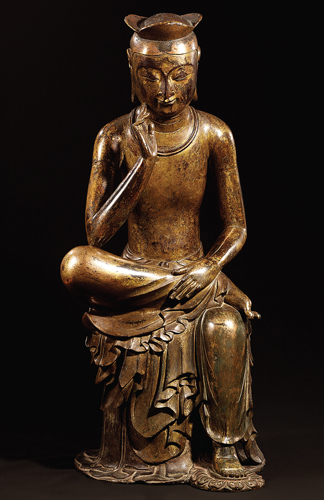
This meditating Bodhisattva was made at the time of the introduction of Buddhism to which country?
A) Japan
B) Cambodia
C) Indonesia
D) Korea

This meditating Bodhisattva was made at the time of the introduction of Buddhism to which country?
A) Japan
B) Cambodia
C) Indonesia
D) Korea

Unlock Deck
Unlock for access to all 50 flashcards in this deck.
Unlock Deck
k this deck
29
Korea's artistic golden age occurred during which of the following periods?
A) Goguryeo kingdom
B) Baekje kingdom
C) Yi kingdom
D) Silla kingdom
A) Goguryeo kingdom
B) Baekje kingdom
C) Yi kingdom
D) Silla kingdom

Unlock Deck
Unlock for access to all 50 flashcards in this deck.
Unlock Deck
k this deck
30
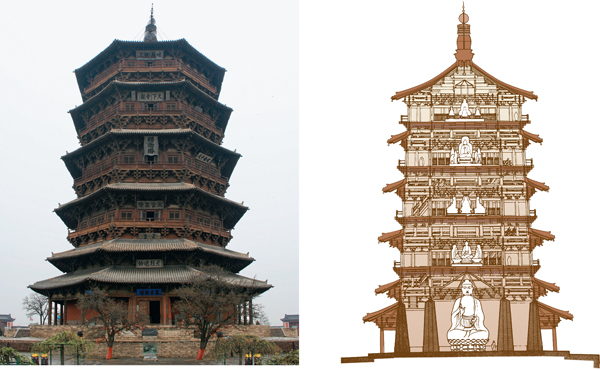
What construction technique was used to build the Fogong Si Pagoda?
A) Post and lintel
B) Beam and bracket
C) Corbelling
D) Nail and daub

What construction technique was used to build the Fogong Si Pagoda?
A) Post and lintel
B) Beam and bracket
C) Corbelling
D) Nail and daub

Unlock Deck
Unlock for access to all 50 flashcards in this deck.
Unlock Deck
k this deck
31
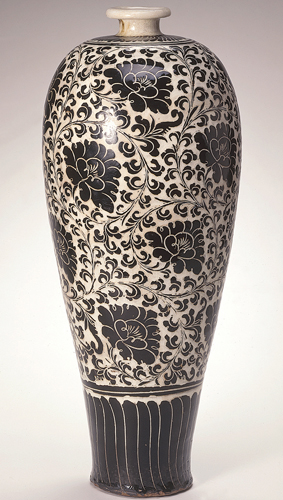
What technique was used to decorate this vase?
A) Stamping
B) Rubbing
C) Sgraffito
D) Lalitsana

What technique was used to decorate this vase?
A) Stamping
B) Rubbing
C) Sgraffito
D) Lalitsana

Unlock Deck
Unlock for access to all 50 flashcards in this deck.
Unlock Deck
k this deck
32
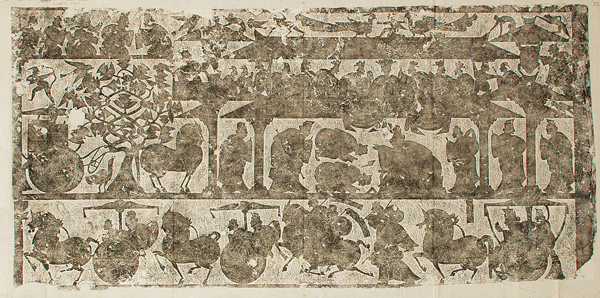
The ceremonial scenes showing homage and loyalty in this relief from the Wu family shrine are reflections of which belief system in Han society?
A) Buddhism
B) Confucianism
C) Daoism
D) Hinduism

The ceremonial scenes showing homage and loyalty in this relief from the Wu family shrine are reflections of which belief system in Han society?
A) Buddhism
B) Confucianism
C) Daoism
D) Hinduism

Unlock Deck
Unlock for access to all 50 flashcards in this deck.
Unlock Deck
k this deck
33
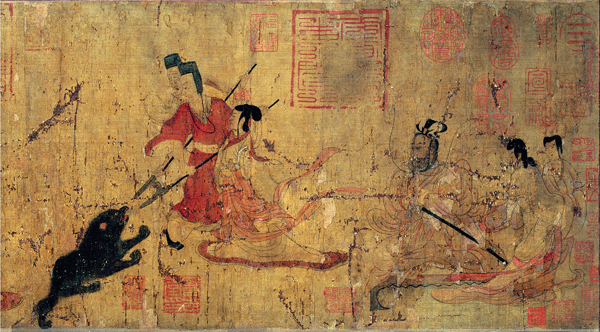
What is the title of this scene?
A) Shi Huangdi and the Fairy
B) Princess Yongtai and Her Ladies
C) Emperor Huizong and the Cranes
D) Lady Feng and the Bear

What is the title of this scene?
A) Shi Huangdi and the Fairy
B) Princess Yongtai and Her Ladies
C) Emperor Huizong and the Cranes
D) Lady Feng and the Bear

Unlock Deck
Unlock for access to all 50 flashcards in this deck.
Unlock Deck
k this deck
34
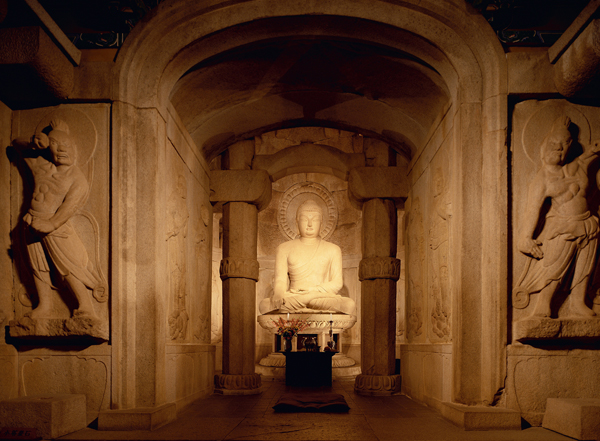
What is the location of the structure and statue depicted here?
A) Yingxian
B) Gyeongju
C) Seokguram
D) Xi'an

What is the location of the structure and statue depicted here?
A) Yingxian
B) Gyeongju
C) Seokguram
D) Xi'an

Unlock Deck
Unlock for access to all 50 flashcards in this deck.
Unlock Deck
k this deck
35
Ethnically, the Koreans are related to which of the following peoples?
A) Aryans
B) Gandharans
C) Siberians and Mongolians
D) Chinese
A) Aryans
B) Gandharans
C) Siberians and Mongolians
D) Chinese

Unlock Deck
Unlock for access to all 50 flashcards in this deck.
Unlock Deck
k this deck
36
The imagery on the silk banner discovered in the tomb of the marquise of Dai is thought to represent which of the following?
A) The story of her life
B) The heavenly, human, and underworld realms
C) The history of the Han
D) Her ancestry
A) The story of her life
B) The heavenly, human, and underworld realms
C) The history of the Han
D) Her ancestry

Unlock Deck
Unlock for access to all 50 flashcards in this deck.
Unlock Deck
k this deck
37
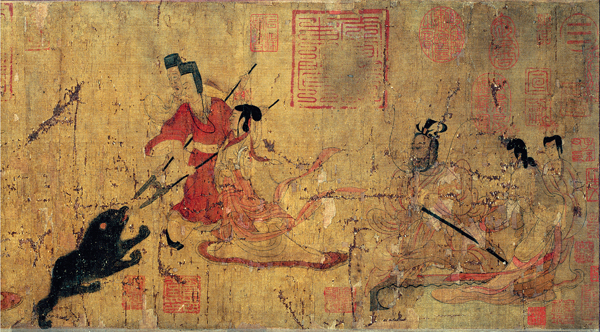
Who is the painter of this handscroll scene?
A) Ma Yuan
B) Fan Kuan
C) Gu Kaizhi
D) Huizong

Who is the painter of this handscroll scene?
A) Ma Yuan
B) Fan Kuan
C) Gu Kaizhi
D) Huizong

Unlock Deck
Unlock for access to all 50 flashcards in this deck.
Unlock Deck
k this deck
38

Zhou Jichang uses color in this painting for symbolic purposes, in accordance with the writings of which individual?
A) Huizong
B) Confucius
C) Buddha
D) Xie

Zhou Jichang uses color in this painting for symbolic purposes, in accordance with the writings of which individual?
A) Huizong
B) Confucius
C) Buddha
D) Xie

Unlock Deck
Unlock for access to all 50 flashcards in this deck.
Unlock Deck
k this deck
39

What material makes up this Chinese bi disk with dragon?
A) Ceramic
B) Bronze
C) Jade
D) Sandstone

What material makes up this Chinese bi disk with dragon?
A) Ceramic
B) Bronze
C) Jade
D) Sandstone

Unlock Deck
Unlock for access to all 50 flashcards in this deck.
Unlock Deck
k this deck
40
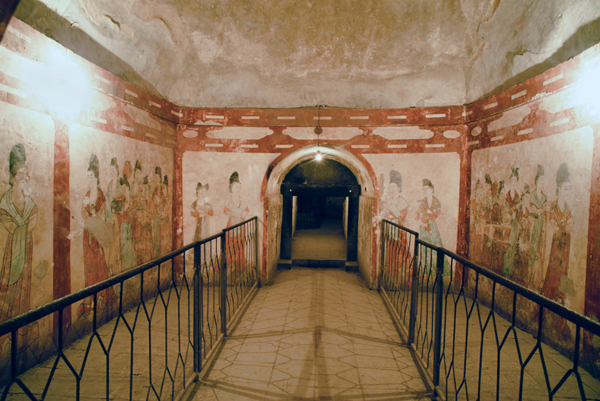
During which dynasty were the tomb of Princess Yongtai and its paintings created?
A) Qin
B) Six Dynasties
C) Tang
D) Southern Song

During which dynasty were the tomb of Princess Yongtai and its paintings created?
A) Qin
B) Six Dynasties
C) Tang
D) Southern Song

Unlock Deck
Unlock for access to all 50 flashcards in this deck.
Unlock Deck
k this deck
41
The accomplishments of the Korean Unified Sillan Kingdom are contemporaneous with which Chinese dynasty?
A) Southern Song
B) Liao
C) Tang
D) Six Dynasties
A) Southern Song
B) Liao
C) Tang
D) Six Dynasties

Unlock Deck
Unlock for access to all 50 flashcards in this deck.
Unlock Deck
k this deck
42
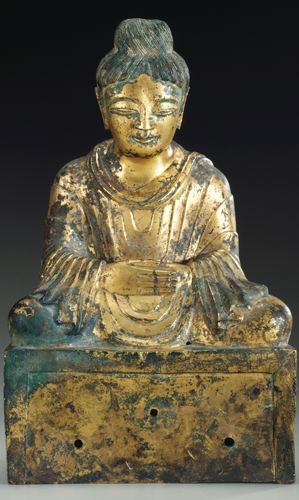
What is the date of the Shakyamuni Buddha, the earliest precisely datable Chinese image of the Buddha?
A) Tang dynasty
B) Six Dynasties
C) Qin dynasty
D) Liao dynasty

What is the date of the Shakyamuni Buddha, the earliest precisely datable Chinese image of the Buddha?
A) Tang dynasty
B) Six Dynasties
C) Qin dynasty
D) Liao dynasty

Unlock Deck
Unlock for access to all 50 flashcards in this deck.
Unlock Deck
k this deck
43
Which complex in China was the site of hundreds of rock-cut shrines and sculptures during the Northern Wei and the Tang dynasties?
A) Mount Wutai
B) Dunhuang
C) Hebei Province
D) Longmen Caves
A) Mount Wutai
B) Dunhuang
C) Hebei Province
D) Longmen Caves

Unlock Deck
Unlock for access to all 50 flashcards in this deck.
Unlock Deck
k this deck
44
Which group played an especially significant role as patrons of Chinese art?
A) Monks
B) Women
C) Peasants
D) Farmers
A) Monks
B) Women
C) Peasants
D) Farmers

Unlock Deck
Unlock for access to all 50 flashcards in this deck.
Unlock Deck
k this deck
45
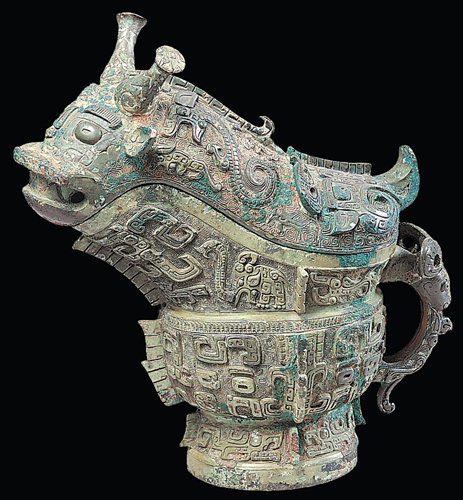
Under which dynasty were these elaborate cast-bronze vessels produced?
A) Southern Song
B) Six Dynasties
C) Shang
D) Tang

Under which dynasty were these elaborate cast-bronze vessels produced?
A) Southern Song
B) Six Dynasties
C) Shang
D) Tang

Unlock Deck
Unlock for access to all 50 flashcards in this deck.
Unlock Deck
k this deck
46
What term do art historians use to describe the varnishlike substance made from the sap of the Asiatic sumac used to decorate wood furniture and other objects?
A) Gilt
B) Lacquer
C) Jade
D) Purlin
A) Gilt
B) Lacquer
C) Jade
D) Purlin

Unlock Deck
Unlock for access to all 50 flashcards in this deck.
Unlock Deck
k this deck
47
The compositional device of pairing two human figures facing into and out of the picture is used in which monument?
A) Wu family shrines
B) Tomb of Yongtai
C) Cave 172, Dunhuang
D) Tomb of the Marquise of Dai
A) Wu family shrines
B) Tomb of Yongtai
C) Cave 172, Dunhuang
D) Tomb of the Marquise of Dai

Unlock Deck
Unlock for access to all 50 flashcards in this deck.
Unlock Deck
k this deck
48
Which of the following Chinese works is closest in function to an Indian stupa?
A) Sui altarpiece
B) Nanchan Temple
C) Fogong Si Pagoda
D) Tomb of Yongtai
A) Sui altarpiece
B) Nanchan Temple
C) Fogong Si Pagoda
D) Tomb of Yongtai

Unlock Deck
Unlock for access to all 50 flashcards in this deck.
Unlock Deck
k this deck
49
Chan Buddhist beliefs developed under the Song emperors had a great effect on the art of which country?
A) Java
B) India
C) Japan
D) Australia
A) Java
B) India
C) Japan
D) Australia

Unlock Deck
Unlock for access to all 50 flashcards in this deck.
Unlock Deck
k this deck
50
What is the function of the silk textile found in the tomb of the Marquise of Dai?
A) Painted mural
B) Embroidered robe
C) Vertical scroll
D) Funeral banner
A) Painted mural
B) Embroidered robe
C) Vertical scroll
D) Funeral banner

Unlock Deck
Unlock for access to all 50 flashcards in this deck.
Unlock Deck
k this deck



